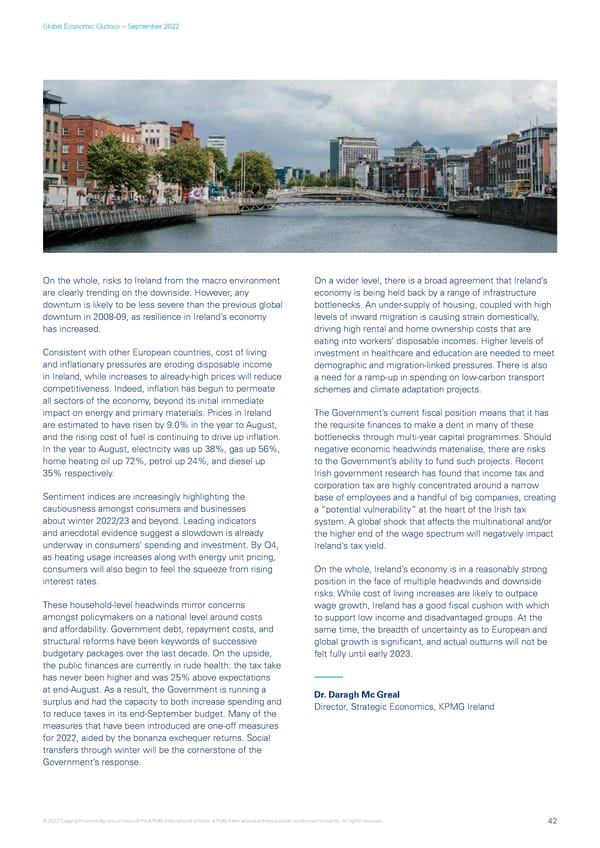Global Economic Outlook – September 2022 On the whole, risks to Ireland from the macro environment On a wider level, there is a broad agreement that Ireland’s are clearly trending on the downside. However, any economy is being held back by a range of infrastructure downturn is likely to be less severe than the previous global bottlenecks. An under-supply of housing, coupled with high downturn in 2008-09, as resilience in Ireland’s economy levels of inward migration is causing strain domestically, has increased. driving high rental and home ownership costs that are eating into workers’ disposable incomes. Higher levels of Consistent with other European countries, cost of living investment in healthcare and education are needed to meet and inflationary pressures are eroding disposable income demographic and migration-linked pressures. There is also in Ireland, while increases to already-high prices will reduce a need for a ramp-up in spending on low-carbon transport competitiveness. Indeed, inflation has begun to permeate schemes and climate adaptation projects. all sectors of the economy, beyond its initial immediate impact on energy and primary materials. Prices in Ireland The Government’s current fiscal position means that it has are estimated to have risen by 9.0% in the year to August, the requisite finances to make a dent in many of these and the rising cost of fuel is continuing to drive up inflation. bottlenecks through multi-year capital programmes. Should In the year to August, electricity was up 38%, gas up 56%, negative economic headwinds materialise, there are risks home heating oil up 72%, petrol up 24%, and diesel up to the Government’s ability to fund such projects. Recent 35% respectively. Irish government research has found that income tax and corporation tax are highly concentrated around a narrow Sentiment indices are increasingly highlighting the base of employees and a handful of big companies, creating cautiousness amongst consumers and businesses a “potential vulnerability” at the heart of the Irish tax about winter 2022/23 and beyond. Leading indicators system. A global shock that affects the multinational and/or and anecdotal evidence suggest a slowdown is already the higher end of the wage spectrum will negatively impact underway in consumers’ spending and investment. By Q4, Ireland’s tax yield. as heating usage increases along with energy unit pricing, consumers will also begin to feel the squeeze from rising On the whole, Ireland’s economy is in a reasonably strong interest rates. position in the face of multiple headwinds and downside risks. While cost of living increases are likely to outpace These household-level headwinds mirror concerns wage growth, Ireland has a good fiscal cushion with which amongst policymakers on a national level around costs to support low income and disadvantaged groups. At the and affordability. Government debt, repayment costs, and same time, the breadth of uncertainty as to European and structural reforms have been keywords of successive global growth is significant, and actual outturns will not be budgetary packages over the last decade. On the upside, felt fully until early 2023. the public finances are currently in rude health: the tax take has never been higher and was 25% above expectations at end-August. As a result, the Government is running a Dr. Daragh Mc Greal surplus and had the capacity to both increase spending and Director, Strategic Economics, KPMG Ireland to reduce taxes in its end-September budget. Many of the measures that have been introduced are one-off measures for 2022, aided by the bonanza exchequer returns. Social transfers through winter will be the cornerstone of the Government’s response. © 2022 Copyright owned by one or more of the KPMG International entities. KPMG International entities provide no services to clients. All rights reserved. 42
 KPMG Global Economic Outlook - H2 2022 report Page 41 Page 43
KPMG Global Economic Outlook - H2 2022 report Page 41 Page 43